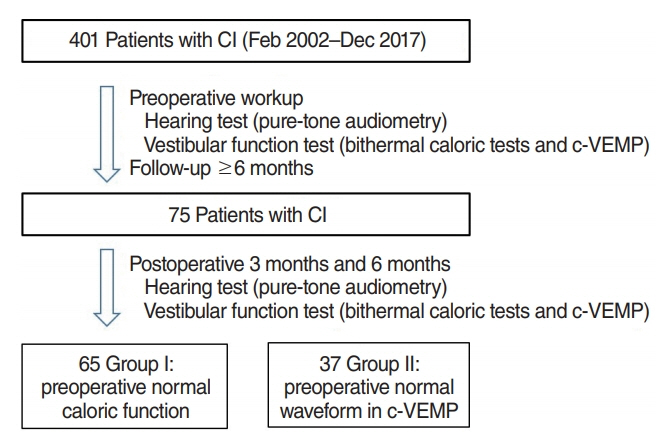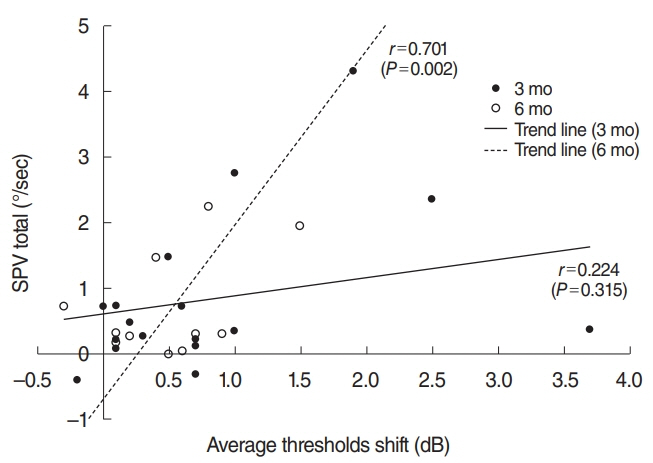Clin Exp Otorhinolaryngol.
2021 Feb;14(1):69-75. 10.21053/ceo.2019.01851.
Changes in Vestibular Symptoms and Function After Cochlear Implantation: Relevant Factors and Correlations With Residual Hearing
- Affiliations
-
- 1Department of Otorhinolaryngology, Ajou University School of Medicine, Suwon, Korea
- 2BK21 Plus Research Center for Biomedical Sciences, Ajou University Graduate School of Medicine, Suwon, Korea
- KMID: 2512883
- DOI: http://doi.org/10.21053/ceo.2019.01851
Abstract
Objectives
. The aim of this study was to evaluate vestibular function loss after cochlear implantation (CI) and the relationship between vestibular function and hearing changes.
Methods
. Seventy-five patients with CI were enrolled and divided into those with normal preoperative caloric function (group I) and those with a normal preoperative waveform in cervical vestibular evoked myogenic potential (c-VEMP) testing (group II). The relationship between hearing and changes in the vestibular system was analyzed preoperatively and at 3 and 6 months postoperatively.
Results
. In group I, unilateral weakness on the implanted side was detected in five (7.7%) and eight (12.3%) patients at 3 and 6 months post-CI, respectively. By 3 months post-CI, the total slow-phase velocity (SPV; warm and cold stimulations) was significantly different between the implanted and non-implanted sides (P=0.011), and the shift in total SPV from pre- to post-CI was significantly correlated with the average hearing threshold at 6 months post-CI. In group II, an abnormal c-VEMP was detected on the implanted side in six patients (16.2%) at 3 months post-CI, and in six patients (16.2%) at 6 months post-CI. Significant changes were noticed in the P1 and N1 amplitude at 3 months postCI (P=0.027 and P=0.019, respectively).
Conclusion
. Vestibular function and residual hearing function should be afforded equal and simultaneous consideration in terms of preservation.
Keyword
Figure
Cited by 1 articles
-
The Need to Consider Vestibular Function in Cochlear Implantation
Yoon Chan Rah
Clin Exp Otorhinolaryngol. 2021;14(1):7-8. doi: 10.21053/ceo.2021.00122.
Reference
-
1. Santa Maria PL, Domville-Lewis C, Sucher CM, Chester-Browne R, Atlas MD. Hearing preservation surgery for cochlear implantation: hearing and quality of life after 2 years. Otol Neurotol. 2013; Apr. 34(3):526–31.2. Gstoettner WK, Helbig S, Maier N, Kiefer J, Radeloff A, Adunka OF. Ipsilateral electric acoustic stimulation of the auditory system: results of long-term hearing preservation. Audiol Neurootol. 2006; 11 Suppl 1:49–56.
Article3. Eshraghi AA, Ahmed J, Krysiak E, Ila K, Ashman P, Telischi FF, et al. Clinical, surgical, and electrical factors impacting residual hearing in cochlear implant surgery. Acta Otolaryngol. 2017; Apr. 137(4):384–8.
Article4. Rajan GP, Kuthubutheen J, Hedne N, Krishnaswamy J. The role of preoperative, intratympanic glucocorticoids for hearing preservation in cochlear implantation: a prospective clinical study. Laryngoscope. 2012; Jan. 122(1):190–5.
Article5. Hansel T, Gauger U, Bernhard N, Behzadi N, Romo Ventura ME, Hofmann V, et al. Meta-analysis of subjective complaints of vertigo and vestibular tests after cochlear implantation. Laryngoscope. 2018; Sep. 128(9):2110–23.6. Fina M, Skinner M, Goebel JA, Piccirillo JF, Neely JG, Black O. Vestibular dysfunction after cochlear implantation. Otol Neurotol. 2003; Mar. 24(2):234–42.
Article7. Ito J. Influence of the multichannel cochlear implant on vestibular function. Otolaryngol Head Neck Surg. 1998; Jun. 118(6):900–2.
Article8. Kubo T, Yamamoto K, Iwaki T, Doi K, Tamura M. Different forms of dizziness occurring after cochlear implant. Eur Arch Otorhinolaryngol. 2001; Jan. 258(1):9–12.
Article9. Todt I, Basta D, Ernst A. Does the surgical approach in cochlear implantation influence the occurrence of postoperative vertigo. Otolaryngol Head Neck Surg. 2008; Jan. 138(1):8–12.
Article10. Tien HC, Linthicum FH Jr. Histopathologic changes in the vestibule after cochlear implantation. Otolaryngol Head Neck Surg. 2002; Oct. 127(4):260–4.
Article11. Handzel O, Burgess BJ, Nadol JB Jr. Histopathology of the peripheral vestibular system after cochlear implantation in the human. Otol Neurotol. 2006; Jan. 27(1):57–64.
Article12. Nordfalk KF, Rasmussen K, Hopp E, Bunne M, Silvola JT, Jablonski GE. Insertion depth in cochlear implantation and outcome in residual hearing and vestibular function. Ear Hear. 2016; Mar-Apr. 37(2):e129–37.
Article13. Nordfalk KF, Rasmussen K, Hopp E, Greisiger R, Jablonski GE. Scalar position in cochlear implant surgery and outcome in residual hearing and the vestibular system. Int J Audiol. 2014; Feb. 53(2):121–7.
Article14. Xu XD, Zhang XT, Zhang Q, Hu J, Chen YF, Xu M. Ocular and cervical vestibular-evoked myogenic potentials in children with cochlear implant. Clin Neurophysiol. 2015; Aug. 126(8):1624–31.
Article15. Frodlund J, Harder H, Maki-Torkko E, Ledin T. Vestibular function after cochlear implantation: a comparison of three types of electrodes. Otol Neurotol. 2016; Dec. 37(10):1535–40.16. Enticott JC, Eastwood HT, Briggs RJ, Dowell RC, O’Leary SJ. Methylprednisolone applied directly to the round window reduces dizziness after cochlear implantation: a randomized clinical trial. Audiol Neurootol. 2011; 16(5):289–303.
Article17. Rah YC, Park JH, Park JH, Choi BY, Koo JW. Dizziness and vestibular function before and after cochlear implantation. Eur Arch Otorhinolaryngol. 2016; Nov. 273(11):3615–21.
Article18. Basta D, Todt I, Goepel F, Ernst A. Loss of saccular function after cochlear implantation: the diagnostic impact of intracochlear electrically elicited vestibular evoked myogenic potentials. Audiol Neurootol. 2008; 13(3):187–92.
Article19. Katsiari E, Balatsouras DG, Sengas J, Riga M, Korres GS, Xenelis J. Influence of cochlear implantation on the vestibular function. Eur Arch Otorhinolaryngol. 2013; Feb. 270(2):489–95.
Article20. Meli A, Aud BM, Aud ST, Aud RG, Cristofari E. Vestibular function after cochlear implant surgery. Cochlear Implants Int. 2016; May. 17(3):151–7.
Article21. Rossi G, Solero P, Rolando M, Spadola Bisetti M. Vestibular function and cochlear implant. ORL J Otorhinolaryngol Relat Spec. 1998; Mar-Apr. 60(2):85–7.
Article22. Kluenter HD, Lang-Roth R, Guntinas-Lichius O. Static and dynamic postural control before and after cochlear implantation in adult patients. Eur Arch Otorhinolaryngol. 2009; Oct. 266(10):1521–5.
Article23. Krause E, Louza JP, Hempel JM, Wechtenbruch J, Rader T, Gurkov R. Effect of cochlear implantation on horizontal semicircular canal function. Eur Arch Otorhinolaryngol. 2009; Jun. 266(6):811–7.
Article24. Robard L, Hitier M, Lebas C, Moreau S. Vestibular function and cochlear implant. Eur Arch Otorhinolaryngol. 2015; Mar. 272(3):523–30.
Article25. Louza J, Mertes L, Braun T, Gurkov R, Krause E. Influence of insertion depth in cochlear implantation on vertigo symptoms and vestibular function. Am J Otolaryngol. 2015; Mar-Apr. 36(2):254–8.
Article
- Full Text Links
- Actions
-
Cited
- CITED
-
- Close
- Share
- Similar articles
-
- Balance Problem after Cochlear Implantation
- Auditory Rehabilitation - Cochlear Implantation
- A Case of Electric Acoustic Stimulation Cochlear Implantation in Partial Deafness with Residual Low-Frequency Hearing
- Effect of Bimodal Hearing in Speech Perception Under Noisy Environment According to Residual Hearing
- Simultaneous Translabyrinthine Tumor Removal and Cochlear Implantation in Vestibular Schwannoma Patients





